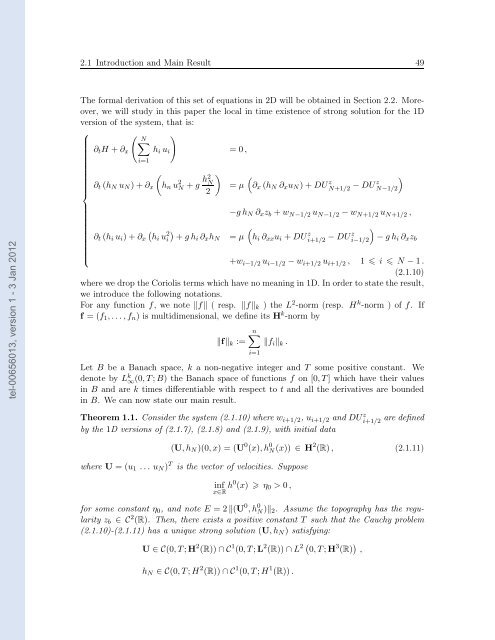Modélisation, analyse mathématique et simulations numériques de ...
Modélisation, analyse mathématique et simulations numériques de ...
Modélisation, analyse mathématique et simulations numériques de ...
Create successful ePaper yourself
Turn your PDF publications into a flip-book with our unique Google optimized e-Paper software.
tel-00656013, version 1 - 3 Jan 2012<br />
2.1 Introduction and Main Result 49<br />
The formal <strong>de</strong>rivation of this s<strong>et</strong> of equations in 2D will be obtained in Section 2.2. Moreover,<br />
we will study in this paper the local in time existence of strong solution for the 1D<br />
version of the system, that is:<br />
⎧ <br />
N<br />
<br />
⎪⎨<br />
∂tH +∂x<br />
i=1<br />
∂t(hN uN)+∂x<br />
hiui<br />
<br />
hnu 2 N +g h2 <br />
N<br />
2<br />
= 0,<br />
= µ<br />
<br />
∂x(hN ∂xuN)+DU z N+1/2 −DUz <br />
N−1/2<br />
−ghN ∂xzb +w N−1/2u N−1/2 −w N+1/2u N+1/2,<br />
<br />
∂t(hiui)+∂x hiu 2 <br />
i +ghi∂xhN = µ hi∂xxui +DU z i+1/2 −DUz <br />
i−1/2 −ghi∂xzb<br />
⎪⎩<br />
+wi−1/2ui−1/2 −wi+1/2ui+1/2, 1 i N −1.<br />
(2.1.10)<br />
where we drop the Coriolis terms which have no meaning in 1D. In or<strong>de</strong>r to state the result,<br />
we introduce the following notations.<br />
For any function f, we note f ( resp. fk ) the L2-norm (resp. Hk-norm ) of f. If<br />
f = (f1,...,fn) is multidimensional, we <strong>de</strong>fine its Hk-norm by<br />
fk :=<br />
n<br />
fik.<br />
i=1<br />
L<strong>et</strong> B be a Banach space, k a non-negative integer and T some positive constant. We<br />
<strong>de</strong>note by Lk ∞ (0,T;B) the Banach space of functions f on [0,T] which have their values<br />
in B and are k times differentiable with respect to t and all the <strong>de</strong>rivatives are boun<strong>de</strong>d<br />
in B. We can now state our main result.<br />
Theorem 1.1. Consi<strong>de</strong>r the system (2.1.10) where w i+1/2, u i+1/2 and DU z i+1/2<br />
by the 1D versions of (2.1.7), (2.1.8) and (2.1.9), with initial data<br />
are <strong>de</strong>fined<br />
(U,hN)(0,x) = (U 0 (x),h 0 N(x)) ∈ H 2 (R), (2.1.11)<br />
where U = (u1 ... uN) T is the vector of velocities. Suppose<br />
inf<br />
x∈R h0 (x) η0 > 0,<br />
for some constant η0, and note E = 2(U 0 ,h 0 N)2. Assume the topography has the regularity<br />
zb ∈ C 2 (R). Then, there exists a positive constant T such that the Cauchy problem<br />
(2.1.10)-(2.1.11) has a unique strong solution (U,hN) satisfying:<br />
U ∈ C(0,T;H 2 (R))∩C 1 (0,T;L 2 (R))∩L 2 0,T;H 3 (R) ,<br />
hN ∈ C(0,T;H 2 (R))∩C 1 (0,T;H 1 (R)).

















